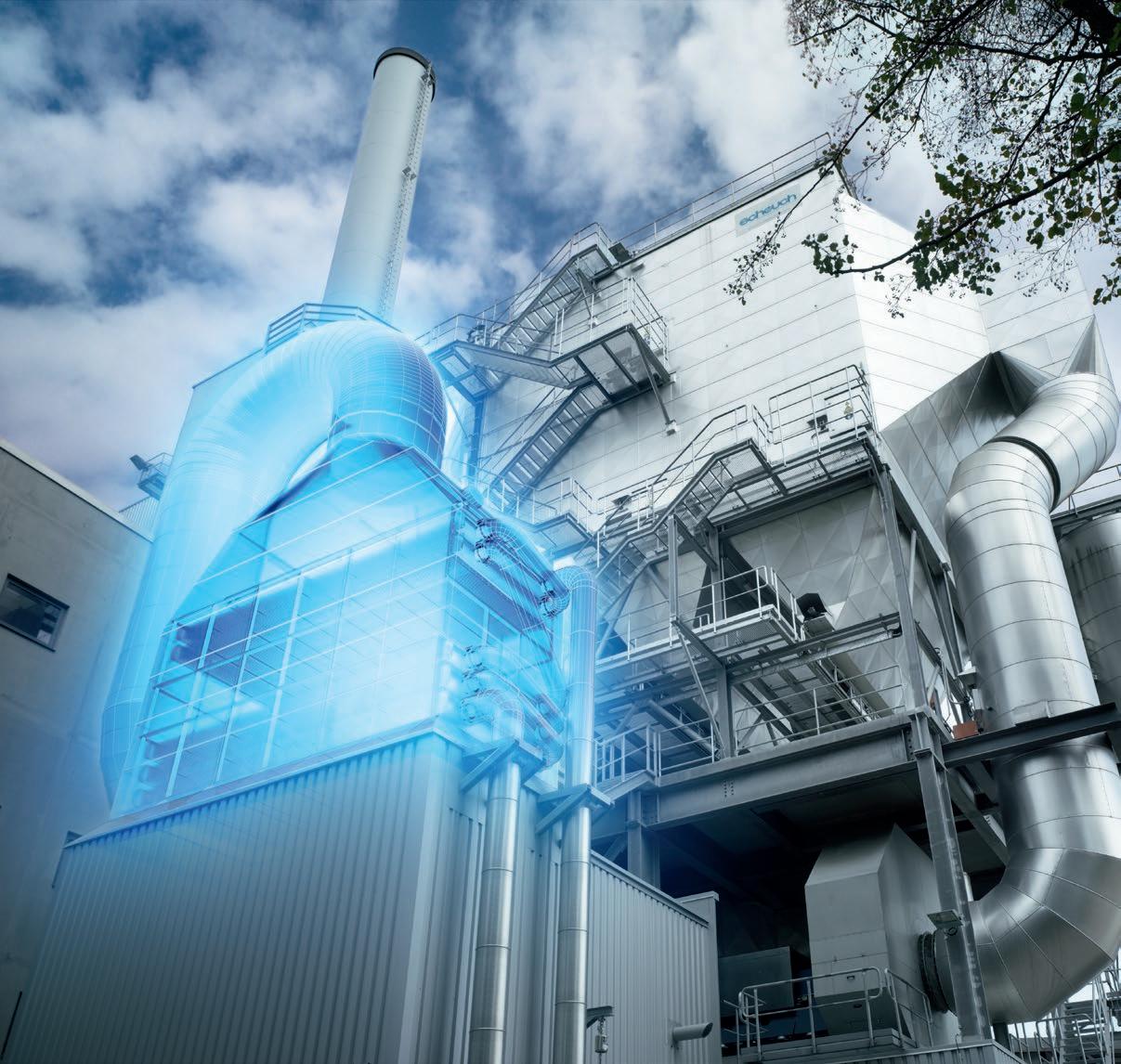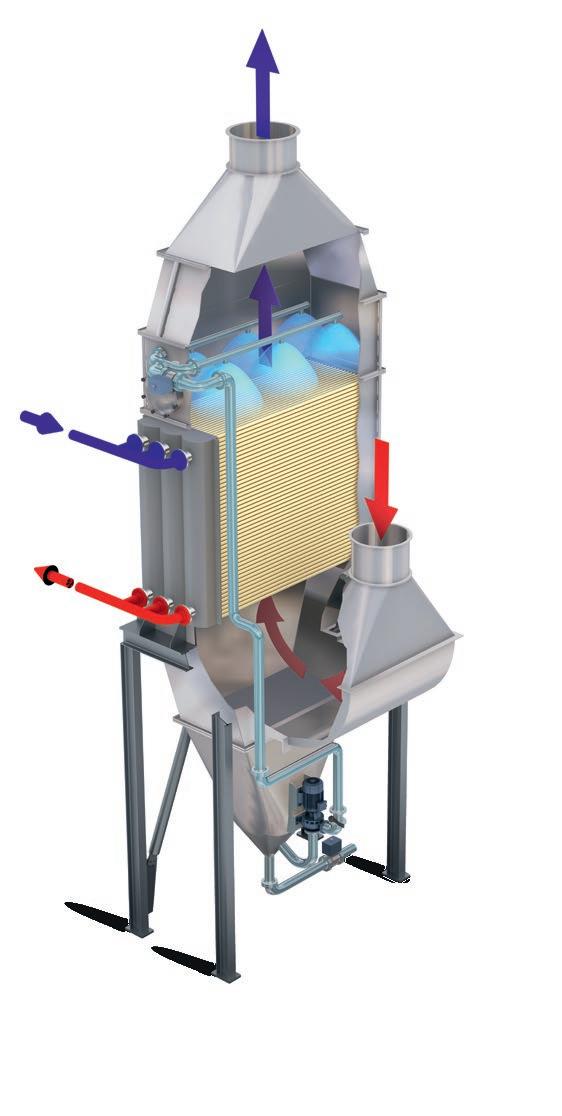MAXIMUM ENERGY GAIN FROM FLUE GASES
ENERGY AND HEAT RECOVERY WITH ERCS


ENERGY AND HEAT RECOVERY WITH ERCS

The first Scheuch flue gas condensation plant for heat recovery was commissioned as early as 1996. Thanks to ongoing development with practice-led experience and intensive research, over the years we have developed the ercs process (Energy Recovery & Cleaning Systems). This system, ensures maximum heat extraction for boiler outputs of up to 200 MW.
The heat recovered from the flue gas can, for example, be used advantageously in the following applications:
▪ Efficiency enhancement for local and district heating networks
▪ Process heat (e.g. for steam or ORC processes)
▪ Drying sawdust, woodchips, fuels or sawn timber
▪ Depluming steam plume at a chimney outlet
▪ Useful heat for industrial processes
The costs for the integration of new ercs systems or for the retrofitting of ercs systems in existing plants is regained through ROI after around two years.
Depending on the plant combination, ercs plants reduce the amount of fine dust by 30 to 60 %. For new plants, the investment costs of de-dusting components are reduced due to their more compact and cost-efficient design. When capacity is increased, the existing limit values continue to be safely observed thanks to the de-dusting effect of a retrofitted ercs plant.
If fuels with a water content of up to w65 are used in winter, up to 50 % of boiler output can be recovered from the exhaust gas. Experience has shown that, depending on the plant configuration and return temperatures, an annual average of between 10 and 25 % of the boiler output is a realistic figure.

▪ Recover 50 % of boiler output in heat
▪ Save 30 % in fuel
As fuel water content increases, the energy content of the fuel falls while the amount of latent heat rises. The heat value of moist fuels is therefore significantly lower than the calorific value.
Our flue gas ercs condensation plants recover up to 50 % of the boiler output from thermal energy in heat contained in otherwise unused flue gas.
The latent heat of the evaporation or condensation heat is recovered by condensing flue gas. In addition, one part of the sensible heat can be extracted by means of a decrease in temperature in the condensation plant.
This increases the efficiency of the complete plant to well over 100%. This dramatically enhances the cost-effectiveness of heat and power stations and biomass heating plants.
▪ Reduce investment costs for the heating plant by 20 % ▪ Minimise particulate emissions
For flexibility in heat usage, it is often necessary to extract thermal energy at various temperature stages. As a unique system on the market, the ercs plant can, for example, provide one part of the heat at 85-105°C and another part at 40-65°C.
WITH HEAT RECOVERY USING OUR ERCS PLANTS, YOU CAN:
Both sensible and latent heat content can be recovered with the flue gas condenser. The energy output from the condenser improves as the return temperature decreases or as the moisture in the flue gas increases.
With the appropriate design, the flue gas close to return temperature is cooled. This allows a temperature difference of less than 3°C.
The heat exchanger consists of high-quality, stainless-steel plain tubes. The flue gas is directed around the tubes and the heating water into the tubes – an additional plate heat exchanger is not necessary.
The plant also features low pressure losses on both the flue gas and heating water side. In addition, permanent flushing is not necessary for heat extraction, meaning that the rinsing pump is only active periodically. This means a 50 % saving of electrical operating costs compared with conventional scrubber systems.

THERMAL HEAT OUTPUT FROM ERCS – TYPE 01
Flue gas temperature 190°C; 8 vol. % O2
TYPE 01
FLUE GAS CONDENSER
Treturn temperature < Tdew point = condenser operation
The ercs – TYPE 02 configuration is used when network return temperatures are high or fuel moisture is low.
Until recently, flue gas condensation could only be operated with an appropriately moist fuel or a return temperature which was low enough. If this is equal to or greater than the water dew point in the fluegas, heat extraction with current designs is impossible.
The ercs – TYPE 02 plant can detect if condenser operation is not efficient and switches automatically to what is known as ECONOMIZER operation.
This allows heat recovery to continue to take place even under conditions where conventional heat recovery systems would no longer be able to work economically or reliable.
▪ High efficiency (temperature difference < 3°C)
▪ Minimal operating costs due to the low flue gas pressure losses
▪ Direct heat transfer from the flue gas to the heating system
▪ Compact design
▪ Can be retrofitted
Fuel moisture w65
Flue gas temperature 190°C ; 8 vol % O2
TYPE 02
Tdew point < Treturn temperature = economizer operation
Condenser operation uneconomical → switches to ECO(nomizer) operation
Fuel moisture w55
Fuel moisture w45
Fuel moisture w30
Network return temperature (°C)
Heat yield even at high return temperatures
Under certain basic conditions, it is beneficial to extract thermal energy at different temperatures levels in order to allow maximum heat usage.
In the first stage, the ECO (economizer) recovers sensible heat on the water side at a temperature level of approx. 110°C. For example, this energy can be used for district heat, process heat or standard drying plants, where higher supply temperatures are beneficial.
In the second stage, the condenser extracts latent heat at a temperature level of approx. 60°C on the water side. This energy is used for local or district heating networks or for drying chipboards, fuel or sawn timber in low-temperature drying chambers.

The lower the return temperature is, the greater the energy output of the condenser. The return temperatures can be further reduced through the use of heat pumps or drying conveyors.
ECO supply temperatures of up to 110°C
ECO return temperatures of over 55°C
Condenser supply temperatures of up to 65°C Condenser return temperatures of up to 55°C
Legal requirements often demand that no visible steam plume is visible at the chimney. This requirement is fulfilled by using the ercs – TYPE 04 configuration air preheaters (LUVO) for depluming. Due to economic considerations, however, this kind of system should always be combined with a flue gas condensation stage.


The cool outdoor air is pre-heated in a crossflow with the flue gas using the LUVO and
mixed with the flue gas by means of a special mixing unit upstream of the chimney. This ensures the plant is completely plume-free even in sub-zero temperatures.
To ensure only the energy actually required for depluming is used, a software tool developed in-house controls the minimum air volume that is necessary.
In addition to depluming, the heat extracted via the LUVO can also be used to dry fuel or pre-heat dryer air for chipboards and sawn timber, for example.

If the heat from the flue gases is used to generate hot air, we incorporate several LUVO stages into our ercs plants. This is advantageous because the heat is transmitted to air which can be used directly, e.g. for drying. This system offers a high level of efficiency because the heat does not have to be transmitted to a water circuit first, but instead is used without transmission losses (simple heat transfer).

The pre-cleaned flue gas flows through the plant in two stages in a cross-counterflow. Cool ambient air is drawn in and directed via the second LUVO stage of the ercs plant. The flue gas
then cools to below the dew point, releasing latent heat. In the first LUVO stage, the pre-heated fresh air is heated up to 90°C, while the sensible heat is extracted from the flue gas.
For example, at firing thermal capacity of 5000 kWtherm, a maximum heat extraction of 2120 kW can be achieved at a fuel moisture content of w65 and with an outdoor temperature of -10°C. This is equivalent to 42 % of the boiler output. Based on experience, an average annual output of 1520 kW can be expected. This means around 11,565 MWh of otherwise unused energy can be economically recovered.
The residual heat contained in the flue gas downstream of the condenser is used to heat and evaporate water. This moisture is transferred to ambient air and directed to the boiler as humidified, pre-heated combustion air. This increases the moisture in the flue gas and the heat recovery in the upstream condenser.
INCREASE IN CONDENSER OUTPUT DUE TO COMBUSTION AIR HUMIDIFICATION with humidification without humidification
Country-specific requirements regarding condensate quality vary considerably. The quality of the condensate accumulated in the condensation plant depends largely on factors such as operational conditions, fuel quality and combustion quality in the boiler.
Scheuch offers a modular system for condensate treatment which allows customers to adapt to increasing demands.
Condensate with very low concentration of heavy metals and ammonium, and < 1 mg/l filterable solids
with very
Useful heat for district heating supply
Project name: Liepaja
Country: Latvia
Design: ercs – TYP 01
Boiler output: 15 MW
Fuel water content: w50
ECRS heat extraction: 3.100 kW
Usage: District heating
Useful heat for district heating supply
Project name: Etouvie
Country: France
Design: ercs – TYP 02
Boiler output: 5 MW
Fuel water content: w40
ECRS heat extraction: 1.000 kW

Usage: District heating
Useful heat for pellet dryers
Project name: Unterbernbach
Country: Germany
Design: ercs – TYP 01
Boiler output: 43,7 MW thermal


ECRS heat extraction: 9.500 kW
Usage: Chip dryer heating
Useful heat for pellet dryers
Project name: Enerbois
Country: Switzerland
Design: ercs – TYP 03
Boiler output: 12 MW
ECRS heat extraction: 3.055 kW of which ECO: 605 kW of which condenser: 2.450 kW

Scheuch GmbH
Weierfing 68
4971 Aurolzmünster
Austria
Phone +43 / 7752 / 905 – 0

Fax +43 / 7752 / 905 – 65000
E-Mail office@scheuch.com
Web www.scheuch.com